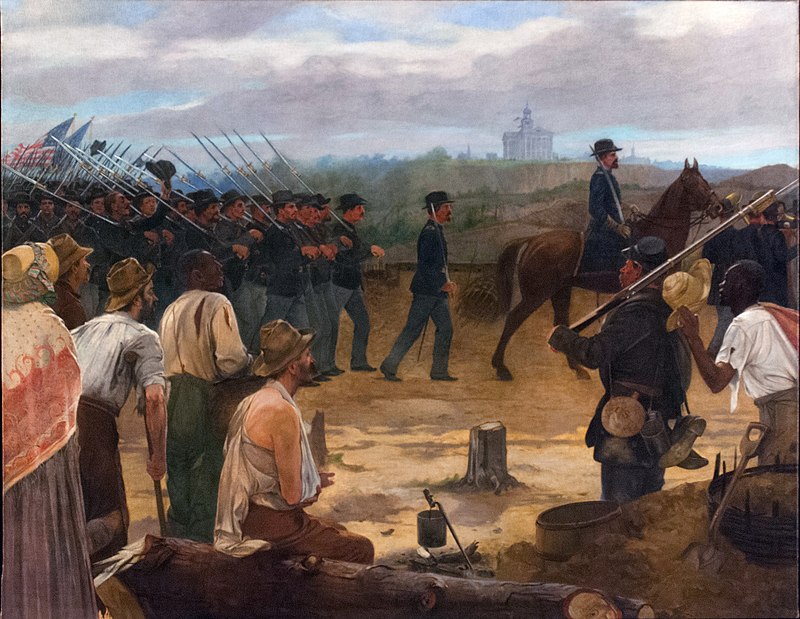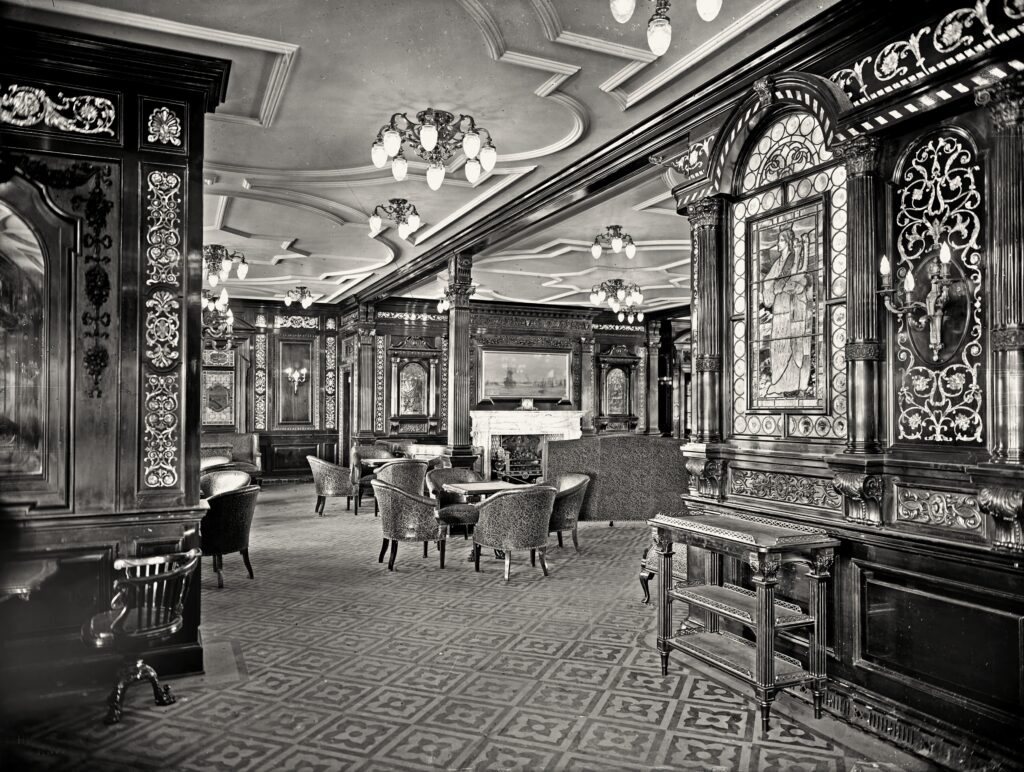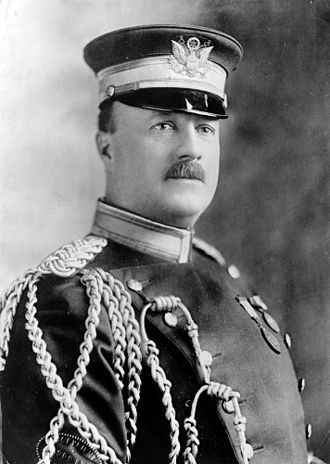Table of Contents
With the loss of the submersible Titan on June 18, 2023, carrying five passengers to visit the wreck of the Titanic 12,500 feet below the ocean’s surface, the infamous shipwreck from 1912 is once again making headlines. One of the passengers aboard the ill-fated Titanic in April of 1912 was Francis Millet who served as a contract assistant surgeon during the Civil War with the 60th Massachusetts Infantry. Millet became a renowned writer and artist who led a full, colorful life that was sadly snuffed out in the icy waters of the North Atlantic. It is almost tragically poetic his life should end this way, as he was born in a small seafaring town built around the shipping industry.

Francis Davis Millet was born November 3, 1848 in Mattapoisett, Massachusetts. Located in Plymouth County, Mattapoisett became renowned in the 1800s for shipbuilding, supplying many vessels to the whaling and shipping industry in the first half of the nineteenth century. At the outbreak of the Civil War in 1861, Millet was 13 years old. In May 1864, he enlisted at age 15 with the 60th Massachusetts Infantry, Co. C as a contract surgeon where he served in this capacity just under two weeks. His underage enlistment was not uncommon for the time, no doubt helped by the fact that he served with his father who was a surgeon. Millet’s journal (https://www.aaa.si.edu/collections/francis-davis-millet-and-millet-family-papers-9048/series-2/reel-5903-frames-265-309) during his brief time as an assistant surgeon provides insight into the horrific aftermath of the Battles of the Wilderness and Spotsylvania’s Court House.

Millet and his father were ordered to report to Dr. Edward Barry Dalton in Fredericksburg, VA on May 15, 1864. Barry was in charge of medical care for the wounded following the Overland Campaign and oversaw the organization and management of hospitals in Fredericksburg. On the way to Fredericksburg, Millet wrote “we met thousands of wounded coming in from the front and so weak they could hardly stand and shot everywhere and some in the legs and walking.” Once in Fredericksburg, Millet and his father were assigned to the 5th Corps Hospital located in the Washington Woolen Mill, which stood about a quarter of a mile above town. Millet and his father stayed there the night of the 15th and the following day, Millet rose early and dressed wounds until around noon and then visited the rebel prisoner hospital. The following day he journeyed to the printing office to obtain books for the injured soldiers to read while convalescing.
On the 19th, Millet was assigned to the 22nd Corps Hospital located in St. Mary of the Immaculate Conception Catholic Church where there were “about 150 [soldiers] I should think and 25 to 30 amputations.” He noted that they worked all through the day and slept in a five by four-foot closet that evening. Millet spent the following day dressing wounds and notes that he “picked out about half a cup of maggots out of one man’s leg.” By May 24th, Millet and his father were relieved from duty, and boarded the George Weems with around 400 wounded bound for Washington. They did not start until nearly nighttime, and Millet wrote that “the loudest storm came up that I ever saw. Hail, and rain blew right on the wounded.”
By the 28th, Millet was back home and on July 1st he enlisted with the One Hundred Days’ Men, Company C, 60th Regiment at North Bridgewater as a drummer. Millet was stationed in Indianapolis and while his company didn’t engage in battle, they did perform guard duty, which he wrote about frequently. He also mentions punishments for certain infractions such as his entry on September 5th. “Today at 2 ½ P.M 2 soldiers from Co. D. were drummed about the camp to the tune ‘Rogue’s March’ one had his head shaved and he had on his breast ‘look out for me boys. I am a thief.’ The other had a label ‘I am his assistant.’”
On October 25th Millet wrote his comrade Hubert Blood came down with typhoid fever and “was out of his head till he died.” On November 3rd, Millet’s 16th birthday, he complained of feeling ill and visiting the doctor for the first time with a bad headache and fever. Four days later he returned to the doctor where his skin was painted with iodine for “skin disease.” On November 30th Millet was mustered out and his wartime career came to an end but his illustrious career as a writer and artist was about to begin.

His life’s work is far too much to go into for the sake of this post, but to briefly highlight, Millet graduated Harvard in 1869 with a degree in Modern Languages and Literature. He worked as a newspaper editor for the Boston Advertiser and enrolled in the Royal Academy of Fine Arts at Antwerp, Belgium. In 1877 he served as a journalist for the New York Herald, London Daily News and as an artist for the London Graphic during the Russian Turkish War. The following year he was a member of the fine arts jury at the Paris exposition and exhibitor in the Salon and British Royal Academy.

On March 11, 1879 Millet married Elizabeth Greely Merrill with his close friend Mark Twain serving as best man. The couple had four children: Kate, Edwin, Laurence, and John. He published a book based on his 1892 travels 1,700 miles down the Danube, From the Black Forest to the Black Sea. He served as director of decorations and ended as master of ceremonies at the World’s Columbian Exhibition (Chicago World’s Fair) of 1893. He painted historical murals for the capitols of Wisconsin and Minnesota and the Baltimore Customs House. He was among the founders of the School of Fine Arts in Boston and involved in the American Academy in Rome.

Millet was on academy business in Rome with his close friend, Archibald Butt, an Army officer and aide to President Taft in early 1912. The pair booked return tickets to New York first class on the Titanic and boarded at Cherbourg, France the evening of April 10, 1912. Millet’s ticket (number 13509) cost 26 pounds 11 shillings (roughly $5,200 today) and he occupied cabin E-38. While on board Millet wrote a letter to his friend Alfred Parsons and posted the letter the following day in Queenstown (now Cobh) Ireland (link to letter transcription https://www.encyclopedia-titanica.org/letter-his-old-friend-alfred-parsons.html) It reads, in part, “I thought I told you my ship was the Titanic. She has everything but taxicabs and theatres … As for the rooms they are larger than the ordinary hotel room and much more luxurious with wooden bedsteads, dressing tables, hot and cold water, etc., etc., electric fans, electric heater and all …You can have no idea of the spaciousness of this ship and the extent and size of the decks.”

The night of the sinking, Millet and Butt were seen by survivor Archibald Gracie playing cards in the smoking room and later helping women and children into the lifeboats. Butt and Millet both went down with the ship. Millet’s body was later recovered by the Canadian ship Mackey Bennett. Among the personal possessions found on his body were a gold pocket watch engraved with “F.D.M”, glasses, two gold studs and a silver tablet bottle. Millet’s body was sent to Boston and buried in East Bridgewater Central Cemetery. Butt’s body was never recovered.

Such was the end of Millet’s life, along with over 1,500 others, victims of the misplaced faith in technology and the heedlessness of the ship’s captain to ice. Their deaths tragically reflect the five recent victims of the Titan who, 111 years later, fell victim to the same misplaced trust and neglect. Will the world learn anything from the tragedy of both the Titanic and the Titan in the next 111 years? It seems very unlikely.
About the Author
Rachel Moses is the Pry House Field Hospital Museum Site Administrator and Retail Manager. She received her MA in History in 2007 from Youngstown State University, where she focused on women’s history. She is a contributing author to Clara Barton Civil War Humanitarian and is co-leader of the National Museum of Civil War Medicine’s book club, Between the Lines.
Sources
https://www.mattapoisett.net/about-mattapoisett
https://www.encyclopedia-titanica.org/titanic-victim/francis-davis-millet.html
https://archive.org/details/dictionaryofamer12amer/page/644/mode/2up?view=theater
https://www.encyclopedia-titanica.org/letter-his-old-friend-alfred-parsons.html
https://antietam.aotw.org/officers.php?officer_id=11411
https://freepages.rootsweb.com/~blackwell/books/ma/BridgewaterNorth/chap14.html


